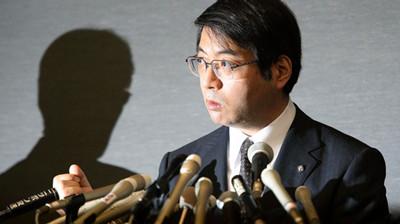(单词翻译:单击)
中英文本
Science in Japan
日本科学界
Stress test
压力测试
After a scandal, a renowned stem-cell scientist commits suicide
爆出丑闻后,一位大名鼎鼎的干细胞科学家自杀
Dr Sasai faces the music
聚光镜前的笹井博士
WHAT happens to human cells if you douse them in a Petri dish full of public shame, official reprimands and months of intense stress? An answer came this week when Yoshiki Sasai, a distinguished stem-cell biologist at the RIKEN Centre for Developmental Biology in Kobe, Japan, hanged himself after being blamed over the fabrication of research.
如果将人类细胞浸入充满公众羞耻、官方谴责以及数月的紧张压力的培养皿中,会发生什么?上周的答案是,著名干细胞生物学家笹井芳树在受尽学术违规的指责后悬梁自尽。笹井芳树生前就职于位于日本神户的理化研究所,是发生与再生科学综合研究中心副主任。

Dr Sasai had been an author, with Haruko Obokata, a younger, female colleague whose work he was supervising and promoting, of two papers published in January in Nature. These promised a leap forward in the much-hyped field of regenerative medicine. They purported to show that applying stress to ordinary mouse cells—squeezing them, or dipping them into a bath of mild acid—could turn them into pluripotent stem cells, capable of forming new animal tissue.
笹井博士是两篇发表于《Nature》杂志上的论文的作者之一。论文第一作者为小保方晴子,是他的女研究生,也是他推荐的文章。文章描绘了当下热门的可再生医学领域的重大进展。论文结果显示,对普通老鼠细胞施加压力,即挤压或将其浸入弱酸中,可能将这些细胞转变为多能型细胞,赋予其形成新的动物组织的能力。
In Japan, where female scientists are a rare species, Dr Obokata's apparent breakthrough caused a sensation. It seemed to open the possibility of more rapid progress towards regenerative medicine's ambitious goals of using pluripotent cells to test new drugs, study diseases, grow tissues and even fashion new body parts to replace damaged or missing ones.
在日本,女性科学家非常罕见。小保方博士的重大突破营造了这样一种感觉:它似乎打开再生医学快速发展的大门,使用多能型细胞测试新药、研究疾病、培养组织甚至塑造新肢体以替代受损或缺失的部分这种宏伟目标有了实现的可能性。
It would also have eclipsed the work of a scientist at Kyoto University who had, in 2006, devised a way of reprogramming ordinary cells into pluripotent ones using genes for molecules called transcription factors. By comparison, the technique Drs Obokata and Sasai suggested was simple.
这份报告超越了京都大学的一位科学家2006年的工作。他发明了一种新的方法,使用分子基因中的转录因子,能将普通细胞转变为多能型细胞。相比之下,小保方博士和笹井博士提出的技术比较简单。
Many other scientists therefore tried to replicate it in the months following publication. But they could not, and doubts grew. Blogs and websites pointed out irregularities in the images and diagrams in the original papers. Finally, in April, an investigative panel at the RIKEN Centre slammed Dr Obokata for fabrication and plagiarism, and in July Natureretracted the papers.
因此,在论文发表后的几个月,许多其他科学家都试图复制这一成果。但他们未能成功,由此开始产生疑虑。博文和网站纷纷指出原始论文的图像和表格中有不合规现象。最终,四月的时候,理化所的调查小组认定存在学术违规和舞弊,7月,《自然》撤回了这两篇论文。
The panel did clear Dr Sasai of misconduct, but it laid upon him a “heavy responsibility” for failing to verify his star researcher's study. He was a keen fundraiser for stem-cell research at RIKEN, which is one of Japan's biggest research organisations, with laboratories all around the country, and that motive may explain his failure to scrutinise her work properly, according to another probe, by outside experts. Disciplinary action against him was expected, and the outsiders called for the Centre for Developmental Biology to be shut down. In April Dr Sasai told the Wall Street Journal that he was “overwhelmed with shame”.
调查小组确实洗清了笹井博士“行为不当”的嫌疑,但是却认定他不曾识别他所谓明星研究人员的成果而负有“重大责任”。外界专家探讨则认为,笹井博士是理化研究中心内,干细胞研究的主要资金募集人员,而理化研究中心则是日本最大的研究机构之一,其实验室遍布全国。这可能是导致他未能正确审议她的工作的原因。人们希望给他纪律处分,外界还有人呼吁关闭发生与再生科学研综合研究中心。四月,笹井博士对《华尔街日报》说,他“满面羞愧”。
But some shame surely also attaches to the scientific establishment's handling of the scandal—particularly in a country where suicide is common. The Knoepfler Lab Stem Cell Blog, a website which has followed the implosion of the papers closely, called this week for all scientists to reflect on the pressure researchers are under to make transformative discoveries. Dr Sasai became a scapegoat, taking too much responsibility for the troubles, it said. Having been briefly in hospital for stress, and on powerful drugs, he had reportedly asked to step aside from his job, only to be turned down. Suicide, unfortunately, is a response that cannot be gainsaid.
但是,对科研机构的丑闻处理也应当受到指责,尤其是在自杀普遍的国家中。 Knoepfler实验室干细胞博客自论文发布以来,一直密切关注。本周他呼吁所有科学家反思研究人员在进行革命性研究时所承担的压力。笹井博士变成了替罪羊,承担了麻烦带来的多数责任。他已经因压力而住院并服用强力药物,并写报告要求离职,却仍被拒绝。不幸的是,自杀却是一项无法被驳回的申请。
词语解释
1.commit suicide 自杀
Why is this? Why is Islam the only religion that motivates its followers to commit suicide missions?
为什么伊斯兰是唯一一个驱动自己的追随者去执行自杀性任务的宗教呢?
So in a letter to her principal, she threatened to commit suicide if her parents pulled her out of school.
因此,她在给校长的一封信里表明,如果父母强迫她离开学校,她就自杀。
2.capable of 有…能力的
Show your teacher what you are capable of.
向你的老师表现出你能干什么。
In the wake of developments in science and technology, man has become more capable of conquering nature.
随着科学技术的发展, 人们征服自然的能力也越来越强了。
3.point out 指出,指明
Can you point out the hotel on this map?
你能指出这家旅馆在地图上的位置吗?
I want to point out one area that I grade the students on, something that many of them dislike.
我想指出我在为学生们评分的一个地方,是他们中许多人都不喜欢的一点。


